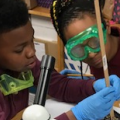Slow and steady: Will the wood turtle win the race against habitat loss?
Turtle biologist Tom Akre explains why the once ubiquitous wood turtle is in a race for its survival.
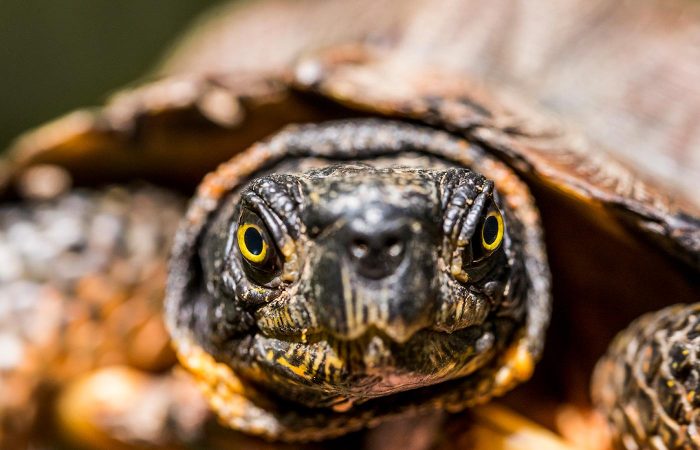
Wood turtles are striking creatures with bright orange scales, yellow plastrons (bellies) and often bright, gold rings around their pupils. In northern populations, turtles tend to be darker and larger to aid in thermoregulation. (Smithsonian’s National Zoo and Conservation Biology Institute)
Smart. Inquisitive. Engaged. Reptilian.
No, we’re not talking about the lizard people Illuminati, but the North American wood turtle (Glyptemys insculpta).
Its personality makes the wood turtle a desirable pet, not only for backyard herpetologists but also for a growing overseas market. Officials have confiscated large numbers of wood turtles in the U.S. and in cities such as Hong Kong, demonstrating the pressure on their wild populations from poachers.
Add development, pollution and disease to the equation and the wood turtle’s future is in danger. Already listed on the International Union for the Conservation of Nature’s Red List of Threatened Species, keeping close track of the distribution and abundance of wild populations of these semi-aquatic creatures will be critical to their well-being, experts say.
Now, a team of researchers from the Smithsonian Conservation Biology Institute in Front Royal, Va., has verified a new method for quickly confirming the presence or absence of wood turtles in a specific habitat that may help with their preservation. Just as our own environments are filled with bits and pieces of DNA from the hair and skin cells we slough off in the course of daily living, invisible particles of turtle DNA float freely in freshwater streams and rivers. These particles can be filtered from water samples and identified, giving biologists a quick and effective way to know where wood turtles are present. Tom Akre, a turtle biologist at SCBI, recently spoke with Torch writer John Barrat about this work and wood turtles in general.
How did this study come about?
In the last decade, it has become quite common for biologists to use traces of DNA in the environment to confirm the presence in a specific area of a variety of different species, such as disease pathogens and endangered or invasive species. Wood turtles, for instance, leave traces of their DNA in stream water by defecating, urinating, shedding skin and mating. By testing water samples and testing them at SCBI’s Center for Conservation Genomics, we can determine if wood turtles live in a particular stream.
Even though this technique has been rapidly adopted and refined by wildlife biologists in recent years, its accuracy and precision are not often tested against conventional surveying methods that we know are reliable. From 2012 to 2014, SCBI conducted visual surveys of wood turtles at dozens of locations across Virginia in a study funded by the U.S. Fish and Wildlife Service through the Virginia Department of Game and Inland Fisheries. We realized these visual surveys of wood turtles offered a perfect opportunity to test the validity of using environmental DNA to survey them.
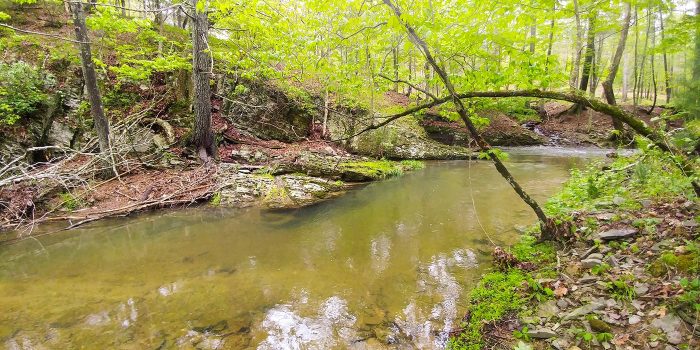
An example of good wood turtle habitat. This mountain stream offers deep pools for spending the winter in as well as plenty of surrounding woodlands in which to look for food when it is warmer out. (Smithsonian’s National Zoo and Conservation Biology Institute)
Jesus Maldonado, Lillian Parker and Nancy McInerney at the National Zoological Park’s Center for Conservation Genetics, Lorien Lemmon of the National Ecological Observatory Network, Ellery Ruther and I put this study together.
Visual surveys are done by having three people walk up a streambed at about a kilometer an hour and visually spot wood turtles in the water or on the bank. The lead surveyor is trained for an extensive period and is validated by an expert at being able to find these turtles. Two follow-up surveyors, who also are trained but not as experienced, walk behind. This was the traditional, uniform approach used to find wood turtles in a comprehensive status assessment of their populations from Maine to Virginia.
Each survey site was visited three times during a single season; on one of the visits water samples were collected and sent to our lab to test for the presence of wood turtle DNA.
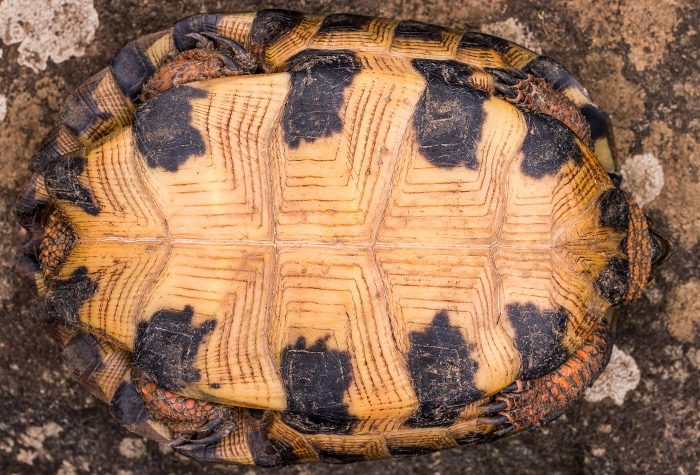
The plastron, or belly, of a female wood turtle. Black pigmentation and the seams between scutes (shell segments) can aid in identifying individuals by photo. (Smithsonian’s National Zoo and Conservation Biology Institute)
What did your study conclude?
Our paper, published April 23 in the journal Plos One , revealed that environmental DNA sampling is just as accurate as traditional visual surveys in determining the presence of wood turtles. In fact, the method we designed for determining the occupancy of wood turtles in a stream using environmental DNA is much cheaper and less invasive than visual surveys.
Previously, it took years to survey a portion of the distribution of wood turtles in Virginia, requiring lots of person power and lots of money. Now we can learn this same information much more quickly, and in almost real time.
At the moment, the problem with DNA surveys is that no one has yet to figure out how to determine the actual number of organisms in a given area. When we get a signal specific to the DNA marker we are interested in from a stream sample we know that wood turtles are present, we just don’t know how many.
This is a powerful tool to manage and protect populations of not only wood turtles but threatened and endangered freshwater turtle populations across the world.
Wood turtles live only in streams?
They are semi-aquatic. In summer, they walk out on land but are usually found within a few hundred meters of a stream. In winter, they burrow down in sand, leaf pack and root wads in stream banks. They can respire underwater because the oxygen tension in these streams is pretty high and in cold temperatures (just above freezing), a wood turtle’s heart beats only a few times a minute. We conducted our visual surveys in early spring and late fall when wood turtles are almost completely aquatic and active in Virginia.
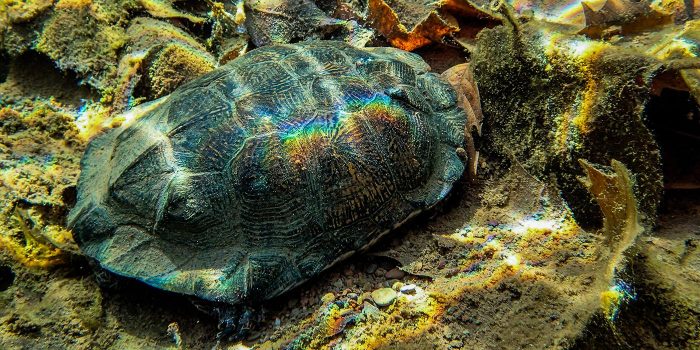
Wood turtles spend colder parts of the year underwater, where the temperature is more stable and always above freezing. Here, a wood turtle rests, inactive, among rocks and leaves at the bottom of a stream. (Smithsonian’s National Zoo and Conservation Biology Institute)
One of our master’s degree students and some SCBI scientists tracking wood turtles with GPS telemetry recently discovered that young male wood turtles can travel as much as 15 to 20 kilometers in one season. The average female or older male wood turtle probably has a home range of between 100 to 200 hectares. The young males move back and forth to find new opportunities for breeding and dominance dominant in the social hierarchy of a wood turtle population, so their travel much farther.
Why are wood turtles in danger?
The long and short of it is their natural habitat has declined tremendously, at the very least across the northeastern United States which is fully half of their range. We just did a status assessment led by colleagues at the University of Massachusetts and the Massachusetts Fish and Wildlife Service, which found that a great deal of their range has contracted as a result of development.
Their numbers are presumably down from historic levels. For example, in Northern Virginia 100 to 50 years ago records show wood turtle populations in the Tysons area, Alexandria, McLean, Great Falls and Sugarland Run area and within spitting distance of National Airport. Now, they are all gone or seriously declined in all of these areas.
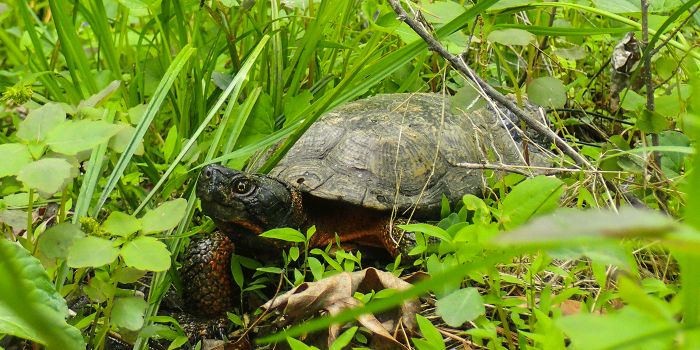
A turtle wandering the riparian area near his home stream. Some research suggests that males may remain closer to streams during warm summer months, while females travel further upland on average. (Smithsonian’s National Zoo and Conservation Biology Institute)
How much of their demise is due to the pet trade?
Occasionally, we find out about confiscations from the U.S. Fish and Wildlife Service of shipments of turtles that were headed overseas or shipments that have arrived in Hong Kong from colleagues there through confiscations by authorities.
It does seem like there is a reasonably active market in collection for the pet trade in Asia and we presume the same is the case in Europe. I’m not an expert on wood turtles in the pet trade although I do participate in a group of biologists, wildlife managers and law enforcement people who are trying to understand the illegal trade in turtles and combat it.
We also know from several recent cases that there is active poaching of turtles along their range, including Virginia.
Three years ago, SCBI took possession of a collection of wood turtles that had been confiscated by the U.S. Fish and Wildlife Service in Florida. Presumably, they were headed overseas for pets. We kept them for three months to make sure they were healthy and disease-free and ultimately repatriated them to an area of West Virginia where the person from whom they were confiscated said they were collected.
Are you doing surveys on other turtle species?
Right now, we are doing the same kind of study on spotted turtles with U.S. Fish and Wildlife Service funding through the VDGIF, to understand the distribution and status of the spotted turtle from Maine to Florida. We’re doing trapping surveys for the spotted turtle now all across the eastern part of Virginia and I would like to see if we could validate the use of environmental DNA for the spotted turtle as well. That is the next project on my list.
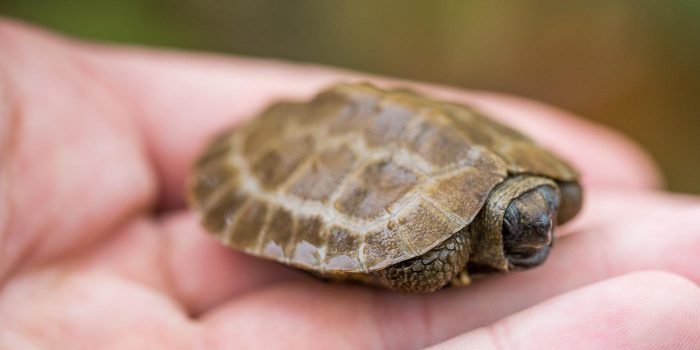
A hatchling wood turtle (Smithsonian’s National Zoo and Conservation Biology Institute)
Might breeding and hatching wood turtles in captivity and releasing them in areas where they are disappearing be a potential solution?
One item that prompted the funding for our survey project is that the wood turtle is being petitioned to be listed under the Endangered Species Act. Part of our deliverables as lead in this project with our colleagues at MassWildlife is to develop a conservation plan for the wood turtle in the northeastern United States. It includes specific measures and habitat management for each of the 13 states in the Northeast.
Some parties have suggested that head-starting juvenile wood turtle hatchlings should be part of that equation, but we haven’t endorsed it because the result hasn’t been uniformly positive.
Sometimes people think of this approach as a means of solving a problem they haven’t even diagnosed. As a case in point, if you are losing habitat in northern Virginia due to development or agriculture, releasing turtle hatchlings is not going to solve the problem.
If you are losing animals to poaching and or you have major predation pressure that has knocked down the population, but the habitat is secure, a monitoring program around a head-starting program might be an appropriate solution.
Historically, head starting has been referred to as a halfway technology because it solves part of the equation but doesn’t actually get to the root of the problem.
(Ed. We like turtles, too.)
Posted: 22 May 2019
